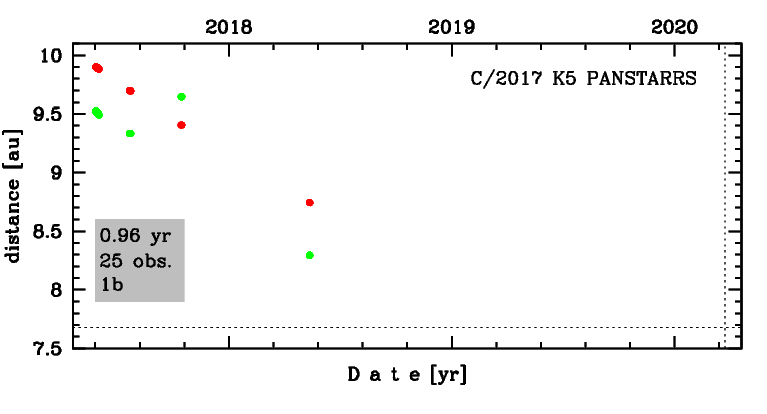C/2017 K5 PANSTARRS
more info
Comet C/2017 K5 was discovered on 27 May 2017 with Pan-STARRS 1 telescope (Haleakala), that is almost 3 years before its perihelion passage. This comet was observed until 9 July 2020.
Comet will have its closest approach to the Earth on 2 July 2020 (6.688 au), a bit more than a 3 months after its perihelion passage.
The preferred solution given here is based on pre-perihelion data spanning over 3.12 yr in a range of heliocentric distances from 9.90 au – 7.68 au (perihelion) – 7.71 au.
This Oort spike comet suffers small planetary perturbations during its passage through the planetary system that likely lead to escape the comet from the planetary zone on a hyperbolic orbit (see future barycentric orbits).
Comet will have its closest approach to the Earth on 2 July 2020 (6.688 au), a bit more than a 3 months after its perihelion passage.
The preferred solution given here is based on pre-perihelion data spanning over 3.12 yr in a range of heliocentric distances from 9.90 au – 7.68 au (perihelion) – 7.71 au.
This Oort spike comet suffers small planetary perturbations during its passage through the planetary system that likely lead to escape the comet from the planetary zone on a hyperbolic orbit (see future barycentric orbits).
| solution description | ||
|---|---|---|
| number of observations | 25 | |
| data interval | 2017 05 27 – 2018 05 12 | |
| data arc selection | data generally limited to pre-perihelion (PRE) | |
| range of heliocentric distances | 9.9 au – 8.74au | |
| detectability of NG effects in the comet's motion | NG effects not determinable | |
| type of model of motion | GR - gravitational orbit | |
| data weighting | NO | |
| number of residuals | 50 | |
| RMS [arcseconds] | 0.35 | |
| orbit quality class | 1b | |
| orbital elements (heliocentric ecliptic J2000) | ||
|---|---|---|
| Epoch | 2020 03 12 | |
| perihelion date | 2020 03 24.31625348 | ± 0.02728133 |
| perihelion distance [au] | 7.67854718 | ± 0.00032727 |
| eccentricity | 1.00600594 | ± 0.00007627 |
| argument of perihelion [°] | 171.840159 | ± 0.003984 |
| ascending node [°] | 102.375784 | ± 0.000336 |
| inclination [°] | 82.262549 | ± 0.000179 |
| reciprocal semi-major axis [10-6 au-1] | -782.17 | ± 10.03 |
